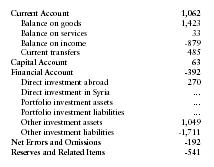Syria - Balance of payments
Syria had serious deficits in its trade balance since 1976, but import restrictions, foreign aid (especially from other Arab governments), and drawdown of foreign exchange holdings enabled the government to cover the losses. Since the late 1980s, the government has been encouraging private sector trade. Private sector exports consequently skyrocketed from $79 million in 1987 to $517 million in 1990, thus reducing the trade deficit. An upturn in world oil prices at the end of the 1990s and into the early 2000s and an improvement in the country's agricultural exports greatly improved the balance of payments situation.
The US Central Intelligence Agency (CIA) reports that in 2001 the purchasing power parity of Syria's exports was $5 billion while imports totaled $4 billion resulting in a trade surplus of $1 billion.
The International Monetary Fund (IMF) reports that in 2000 Syria had exports of goods totaling $5.15 billion and imports totaling $3.7 billion. The services credit totaled $1.7 billion and debit $1.67 billion. The following table summarizes Syria's balance of payments as reported by the IMF for 2000 in millions of US dollars.

| Current Account | 1,062 |
| Balance on goods | 1,423 |
| Balance on services | 33 |
| Balance on income | -879 |
| Current transfers | 485 |
| Capital Account | 63 |
| Financial Account | -392 |
| Direct investment abroad | 270 |
| Direct investment in Syria | … |
| Portfolio investment assets | … |
| Portfolio investment liabilities | … |
| Other investment assets | 1,049 |
| Other investment liabilities | -1,711 |
| Net Errors and Omissions | -192 |
| Reserves and Related Items | -541 |
Comment about this article, ask questions, or add new information about this topic: